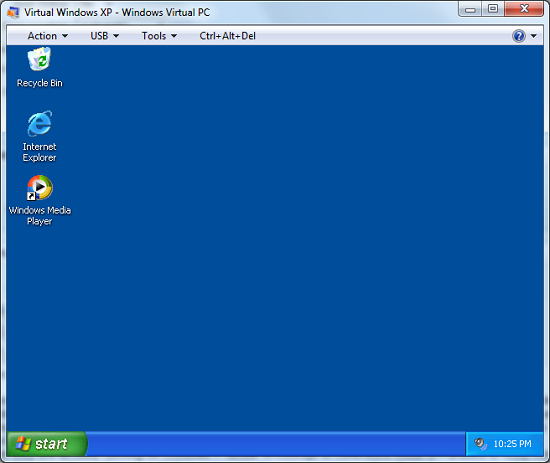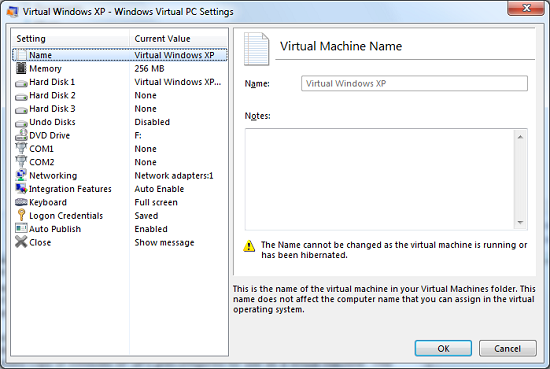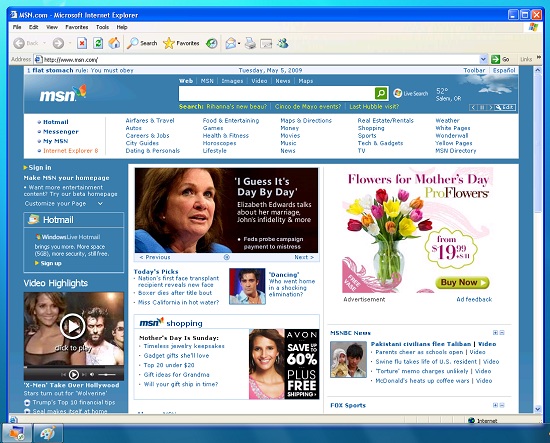Windows 7: Release Candidate 1 Preview
by Ryan Smith and Gary Key on May 5, 2009 11:00 PM EST- Posted in
- Systems
Virtual Windows XP
As we mentioned previously, Microsoft’s big secret unveiled with Windows 7 RC1 is Virtual Windows XP (VXP for short). One of the issues Microsoft has been having in bringing business users over from Win2K and XP to Vista and beyond has been that Windows does not have perfect backwards compatibility. With consumer applications this is not such a big deal since most of those are wide-audience products that get updated regularly, but this is not always the case for business software. Whether it’s some custom in-house application that no one can fix, or a 3rd party application that just works and can’t be updated, business users sometimes can’t escape the fact that they need to be able to run old applications that don’t work in newer operating systems.
VXP is in essence the bone Microsoft is throwing to business users to allow them to run those old applications while using Windows 7. VXP leverages Microsoft’s existing Virtual PC virtualization software that they acquired several years back, by bundling it with a fully licensed copy of Windows XP SP3 preconfigured for use as a virtual machine. This virtual machine can then be partially integrated in Windows 7 so that applications operating inside of it look and behave like they are actually running on Windows XP, similar in concept to the coherence mode of Parallels or Unity mode of VMware. In this case Microsoft is using RDP to connect to the virtual machine rather than screen scraping the entire desktop like Parallels and VMware do. Microsoft does the same thing for the Windows Home Server Console.

VXP Desktop View
As Virtual PC was already free, the significance of this announcement is not the technical details, but rather that Microsoft is endorsing it as an official solution to backwards compatibility problems. It’s long been expected that Microsoft would do something with Virtual PC as a backwards compatibility solution and this is finally it, albeit in a limited role.
Because of the system requirements and issues raised by relying on a virtual machine of XP, VXP is a last-ditch compatibility solution rather than any kind of primary solution. On the system requirement side, VXP requires a processor with hardware virtualization features, along with at least 256MB of RAM and the disk space needed to run the virtual machine. It’s not too bad for a modern system, but it does rule out an older system that may be suitable for upgrading to Windows 7, but not running VXP on top of that.

VXP Configuration
As for the issues raised by using VXP, first and foremost it’s a complete copy of WinXP, with all of its security deficiencies and bugs. It needs security software, it needs administration, and it needs security updates. This also brings up a matter that Microsoft hasn’t answered yet: what happens when WinXP support ends in 2014? Windows 7 will have support until at least 2020, which means either Microsoft is going to drop support for this component of Windows 7 early (an unprecedented move) or they have to extend XP support to match Windows 7’s support cycle. We’re still trying to get a final answer on this.
It should also be noted that VXP only comes with Professional edition and higher, as it’s not intended to be a consumer compatibility solution. And before anyone gets any ideas, it’s not suitable for playing games – the graphics hardware is the usual emulated S3 Trio 64, and the screen does not refresh nearly fast enough to keep up with any kind of action game. Solitaire may be playable, however.

VXP in integrated mode running IE6
At any rate, Virtual Windows XP is a good solution to some compatibility needs, so long as it’s recognized that it’s not the solution to all compatibility needs. For the handful of business users it’s designed for, we would expect that it does its intended job well. However for non-business users that absolutely must have a virtual machine (and won’t need support from Microsoft), it may be worthwhile to look into a free solution like VirtualBox.
Looking towards the future, there has been a lot of speculation that Microsoft may try to make a big break from the Windows APIs in order to clear out all the cruft and deprecated functions that litter their APIs. This isn’t happening today with Windows 7 and VXP, but integrating a virtual machine is the first stepping stone in making it happen. What Microsoft does after VXP is undoubtedly going to be a matter of great interest.










121 Comments
View All Comments
izal169 - Thursday, July 2, 2009 - link
development of the technology is quite rapid. My computer specifications are not strong for Windows 7 that high quality. specification of my computer, intel core 2 duo, 1 Gb RAM, VGA Nvidia 7300 GS. microsoft is very cool. can make the OS with a relatively quick time.http://duitol.com/stop-dreaming-start-action/">http://duitol.com/stop-dreaming-start-action/
deteugma - Friday, June 5, 2009 - link
I was an XP diehard until I installed Windows 7. Now I'm a convert and a proselytizer. I love Windows 7. It will be the first version Windows that I actually buy for myself, rather than accept for free from a family member's employer (university license). MS won't have trouble winning converts from the diehard crowd.Biomorphic - Wednesday, May 27, 2009 - link
Windows 7 has software based audio processing just like Windows Vista and my question is, will VXP enable hardware based audio processing or will it remain software based?PC Reviewer - Monday, May 18, 2009 - link
it looks alright as long as its performance is as good as, if not better than xp's. Im looking to do a review about Windows 7 on my blog soon aswell. http://www.pcreviewer.org">http://www.pcreviewer.orgalon - Sunday, May 17, 2009 - link
First, I did not read all the comments, so if this has already been stated, I do apologize. For that matter, after the "Standard Test Bed" page I stopped reading the article. So .. maybe these issues have already been discussed.1) OK, so Vista x64 SP2 was released around May 11th (at least for my MSDN subscription, possibly earlier for others?) And it appears that the Windows 2008 SP2 bits were released around May
14th. I still don't see an SP2 installer, but I can do a clean install with SP2 already slipstreamed. So ... I've looked and looked, but I can not find an XP Pro x64 SP3 anywhere. And according to Microsoft around last September, there was not going to be an WinXP Pro x64 SP3. So ... if you do have this SP3 around ... please let me know what MSDN/TechNet or whatever subscription you have so I can upgrade mine ... or point me to the release page.
2) Concerning corporate IT ... one of the issues mentioned at the beginning of the article is the computing resources needed to run Vista ... which to me alludes to the fact that many companies chose not to upgrade to Vista based on HW requirements (of course Vista without Aero can run on many "lower" configurations, but of course the average company employee does not know this). I digress ... your test bed platform is not really anything that CorporateIT depts will be deploying. Core i7 ... released 7 months ago ... 6GB RAM. Please ... if you are going to try and "proove" that performance is decent with Windows 7 ... at least run some test systems that are not the toys we dream of, but the systems that are installed in the office. Until Microsoft and folks like you understand that companies can not afford to always buy new HW, the new OSs have to run on the last generation technology (actually more like HW from 2 years ago) ... your comparisons and results are useless ... and my 18month old Lenovo T61 does exactly what I need it to do. So, there would be no reason to upgrade to Win7 until MS End-of-lifes WinXP.
Razer2911 - Wednesday, May 13, 2009 - link
Moving on from Vista 32, I have to say i'm impressed. There are very subtle changes and tweaks which actually make the experience better. A simple example would be the new taskbar, Jump lists and Aero peek feature. I for one dont like a million windows open on my desktop, somehow i always found it cumbersome and cluttered but within a couple of hours of using Windows 7 i found myself using 10-15 windows without getting bothered by the clutter. Never used a Mac but these new features actually have both form and function.One thing that i have not been able to figure out as yet is that all my videos (divx) and movies look very grainy and slightly pixelated on WMP 12 and VLC.
tomb18 - Tuesday, May 12, 2009 - link
Support for canadian television in canada has always been limited in Media Center. Since HD digital over the air broadcasts (atsc)became available in the US, this has been supported in Media Center but not if you lived in Canada. Digital tuners are DISABLED by media center in all versions including Windows 7. This is in spite of the fact that canada uses the same ATSC system as the US. Many hacks have appeared but they always seem to be disabled by updates. This continues in Windows 7. As soon as the software determines that you reside in Canada, it disables the ATSC tuner.But get this. South Korea uses the same ATSC standard and it IS supported in that country.
There are a lot of forums (such as the green button, run by the media center developers)that discuss this to no avail. No amount of questions, emails, or anything will get a comment from Microsoft. Even when MSVP's try to take up the battle nothing gives.
There has been a lot of hope for Windows 7, that it would finally be supported, but alas, it is the status quo. My question is will Microsoft give a warning about the version of Windows 7 that contain media center for the canadian market telling canadians that their digital tuners will not work?
I really wish that some website with industry influence (hint...hint) would expose this pointing out to the canadian market that they should not buy Windows 7 if they want to use the media center.
AnnihilatorX - Tuesday, May 12, 2009 - link
Replace the function of minimising other windows with one that makes the window being shaked always on top. Now this is a useful function.Nevertheless I have been using AutoHotkey (automation programming platform) to assign Alt+z hotkey to make windows always on top in other windows. This is a feature I can't live without, along with Windows key + Scroll wheel on mouse to change transparency. These had help me multitask with different windows very efficiently.
rasmasyean - Sunday, May 10, 2009 - link
I think people might have over-estimated Vista as the OS that will sweep across the world and change computers as we know it over-night. It didn't exactly turn out as expected, but I don't think it doesn't seem it did too bad.Gartner research report predicted that Vista business adoption in 2008 will actually beat that of XP during the same time frame (21.3% vs. 16.9%)[80] while IDC had indicated that the launch of Windows Server 2008 served as a catalyst for the stronger adoption rates.[81][82] As of January 2009, Forrester Research had indicated that almost one third of North American and European corporations have started deploying Vista.[83]
http://en.wikipedia.org/wiki/Windows_Vista">http://en.wikipedia.org/wiki/Windows_Vista
compuser2010 - Sunday, May 10, 2009 - link
"Never underestimate the power of marketing – many people can tell you they don’t like Vista, few can tell you why."I don't like Vista primarily because of built-in Digital Rights Management (DRM). Any time I need to capture, edit and/or transcode audio and/or video, I need to go back to XP.
I have confirmed this with the following programs:
Audacity 1.2.6
Canopus EDIUS Broadcast 4.61
Creative Labs Smart Recorder 2.40.23
Moyea FLV to Video Converter Pro 2
Ulead DVD Workshop 2